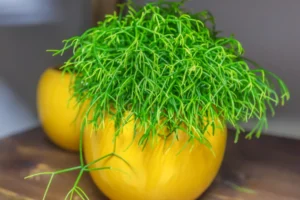Introduction
Welcome to the detailed guide on caring for the Indoor Mistletoe Cactus (Rhipsalis spp.), a unique and enchanting addition to any indoor plant collection. This informative aims to offer a comprehensive understanding of each aspect of caring for this remarkable plant. With its distinctive appearance and relatively easy care requirements, the Mistletoe Cactus makes an excellent choice for both novice and experienced plant enthusiasts. In this guide, we’ll explore everything from the ideal soil mix to the proper way to propagate these charming cacti.
The key specifications of the Indoor Mistletoe Cactus:
| Specification | Details |
|---|---|
| Common Names | Mistletoe Cactus, Spaghetti Cactus (specific to Rhipsalis baccifera), Coral Cactus, etc. |
| Botanical Name | Rhipsalis spp. |
| Family | Cactaceae |
| Plant Type | Epiphytic cactus |
| Mature Size | Varies by species; typically 2-5 ft in length, but can reach up to 20 ft in natural environments |
| Sun Exposure | Bright, indirect light; can tolerate some direct morning sun |
| Soil Type | Well-draining potting mix, preferably formulated for cacti and succulents |
| Soil pH | Slightly acidic to neutral (6.0 to 7.0) |
| Bloom Time | Usually in spring or early summer, depending on the variety |
| Flower Color | White, cream, or pale pink, but flowers are small and not the main attraction |
| Hardiness Zones | Typically 9-11, but mainly grown as an indoor plant in cooler climates |
| Native Area | Central America, South America, parts of Florida and the Caribbean |
| Benefit | Easy to care for, non-toxic to pets, adds unique texture and interest to indoor spaces |
This table should provide a comprehensive overview of the Indoor Mistletoe Cactus, covering all the essential aspects that potential growers or enthusiasts would need to know.
Plant Care
The Mistletoe Cactus is a low-maintenance plant, making it perfect for busy individuals or those new to plant care. It thrives in indirect light and requires a well-draining soil mix. Regular watering is crucial, but be careful not to overwater, as this can lead to root rot.
Light
Light is a crucial factor for the growth and health of your Mistletoe Cactus. These plants prefer bright, indirect light. They can tolerate some direct morning sun but should be shielded from intense afternoon rays, which can scorch their delicate leaves.
Soil
A well-draining soil mix is vital for the health of your Mistletoe Cactus. A mix designed for cacti and succulents, which typically contains perlite or sand, is ideal. This ensures that the roots are not sitting in moisture, which can lead to rot.
Water
Watering your Mistletoe Cactus correctly is key. Allow the soil to dry out partially between waterings. Overwatering can be detrimental, leading to root rot, which is a common issue with this plant.
Temperature and Humidity
Mistletoe Cacti enjoy a warm, humid environment. They thrive in typical household temperatures but prefer to avoid cold drafts. Humidity levels around 50-60% are ideal, so you may need to use a humidifier in drier climates.
Fertilizer
Fertilizing your Mistletoe Cactus can promote healthier growth. Use a balanced, water-soluble fertilizer diluted to half strength, applied monthly during the growing season. Avoid over-fertilizing, as this can harm the plant.
Pruning
Pruning is not only about maintaining the shape and size of your Mistletoe Cactus; it’s also vital for its health. Prune any dead or damaged stems to encourage new growth and improve airflow around the plant.
Overwintering
As a tropical plant, the Mistletoe Cactus needs special care during the winter. Reduce watering and stop fertilizing during this period. Ensure the plant is kept in a warm spot away from cold drafts.
Propagating Plant
Propagating the Mistletoe Cactus is straightforward and rewarding. Cuttings can be taken and rooted in soil or water. This is an excellent way to multiply your collection or share with friends.
Quickly Declining
If your Mistletoe Cactus is declining quickly, it’s essential to assess and address issues such as overwatering, under-watering, pest infestations, or inadequate light. Prompt action can often save the plant.
Types of Mistletoe Cactus
The Mistletoe Cactus family encompasses several varieties, each with its unique charm:
- Rhipsalis baccifera: Often known as the “Spaghetti Cactus,” it features long, slender stems.
- Rhipsalis cereuscula: Recognized by its coral-like appearance, it’s perfect for a textured look.
- Rhipsalis pilocarpa: This variety stands out with its hairy stems, adding a unique tactile element.
- Rhipsalis paradoxa: Known for its intriguing, puzzle-like stem structure.
- Rhipsalis elliptica: Featuring flat, elliptical segments, it’s ideal for a minimalist aesthetic.
Common Pests & Plant Diseases with Solution
The Mistletoe Cactus can encounter pests and diseases, but prompt action can mitigate these issues:
- Pests: Common pests include mealybugs and spider mites. Treat infestations with neem oil or insecticidal soap.
- Diseases: Overwatering can lead to root rot. Ensure proper drainage and allow the soil to dry between waterings. Fungal infections can be treated with a fungicide.
How to Get Mistletoe Cactus to Bloom
Encouraging your Mistletoe Cactus to bloom requires specific conditions:
- Light: Ensure it receives adequate bright, indirect light.
- Temperature: A slight drop in temperature during winter can stimulate flowering.
- Rest Period: Reduce watering in the winter to mimic its natural habitat’s dry season.
- Fertilizing: Use a balanced fertilizer during the growing season to provide necessary nutrients.
Common Problems With Mistletoe Cactus
Even with proper care, you may encounter some issues:
- Leggy Growth: This often indicates inadequate light. Move your plant to a brighter location.
- Discolored Leaves: Yellowing leaves can be a sign of overwatering, while brown, crispy leaves suggest under-watering or too much direct sunlight.
- No Flowering: If your plant doesn’t bloom, it might need more light or a cooler winter rest period.
Final Thoughts on Rhipsalis
The Indoor Mistletoe Cactus, with its diverse varieties and relatively straightforward care requirements
Final Thoughts on Rhipsalis
In conclusion, the Indoor Mistletoe Cactus is an outstanding plant choice for those who love unique and easy-to-care-for houseplants. By following the guidelines outlined in this review, you can ensure your Rhipsalis thrives, providing beauty and enjoyment for years to come.
Frequently Asked Questions
Decode the magic of gardens with our guide to Landscaping Styles Frequently Asked Questions.
- Water when the top inch of soil feels dry. This typically means watering every 1-2 weeks, but adjust based on your home’s humidity and temperature
- While it prefers bright, indirect light, it can tolerate lower light conditions. However, growth may be slower, and the plant may become leggy.
Yes, it is non-toxic to cats and dogs, making it a great choice for pet owners.
- Signs of overwatering include yellowing leaves, a mushy stem, and root rot. Ensure good drainage and allow the soil to dry out partially between waterings.
Recent Posts
- Modern Mural Ideas Transforming Walls into Artworks
- Thematic Table Decor Dressing Your Table for Special Occasions
- Festive Lighting Ideas Brightening Your Home for the Holidays
- Biodegradable Decor Materials Choosing Earth-Friendly Options
- Personalized Space Decor Making Your Home Uniquely Yours
- New Year’s Eve Decor Ringing in the New Year in Style
- Transforming Junk into Decor Upcycling at Its Best
- Second-Life Decor Objects Giving Old Items New Purpose
- Unique Decoration Crafting Standout Ideas for Your Home
- Environmentally Friendly Styling Decor with a Conscience











